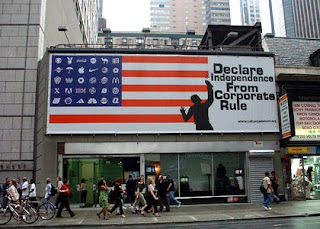The essay 'Culture Jamming: Hacking, Slashing, and Sniping in the Empire of Signs' was written by Mark Derry, the cultural critic, in 1993 and is said to have popularised the concept of culture jamming.
'It is a postmodern commonplace that our lives are intimately and inextricably bound up in the TV experience. Ninety-eight percent of all American households — more than have indoor plumbing — have at least one television, which is on seven hours a day, on the average. Dwindling funds for public schools and libraries, counterpointed by the skyrocketing sales of VCRs and electronic games, have given rise to a culture of “aliteracy,” defined by Roger Cohen as “the rejection of books by children and young adults who know how to read but choose not to.” The drear truth that two thirds of Americans get “most of their information” from television is hardly a revelation.'
'Reality isn’t what it used to be. In America, factory capitalism has been superseded by an information economy characterized by the reduction of labor to the manipulation, on computers, of symbols that stand in for the manufacturing process. The engines of industrial production have slowed, yielding to a phantasmagoric capitalism that produces intangible commodities — Hollywood blockbusters, television sit-coms, catchphrases, jingles, buzzwords, images, one-minute megatrends, financial transactions flickering through fiberoptic bundles. Our wars are Nintendo wars, fought with camera-equipped smart bombs that marry cinema and weaponry in a television that kills. Futurologists predict that the flagship technology of the coming century will be “virtual reality,” a computer-based system that immerses users wearing headgear wired for sight and sound in computer-animated worlds. In virtual reality, the television swallows the viewer, headfirst.'
"the radical politics of visual literacy, an idea eloquently argued by Stuart Ewen, a critic of consumer culture.
'We live at a time when the image has become the predominant mode of public address, eclipsing all other forms in the structuring of meaning,” asserts Ewen. “Yet little in our education prepares us to make sense of the rhetoric, historical development or social implications of the images within our lives.” In a society of heat, light and electronic poltergeists — an eerie otherworld of “illimitable vastness, brilliant light, and the gloss and smoothness of material things”
I found reading the essay useful as to why people would decide to use culture jamming to reject or resist the media environment. This particular section of the essay talks about the 'TV experience' and how, quite depressingly, television has become where we get a large amount of our information from. Within the essay I was most interested in Derry's argument that 'Reality isn't what it used to be' similar to Debord's 'Spectacle' Derry describes our society as 'an eerie otherworld of "illimitable vastness, brilliant light and the gloss and smoothness of material things.'













